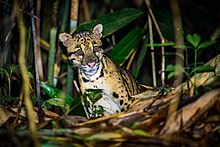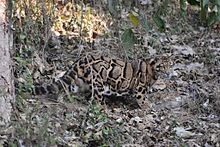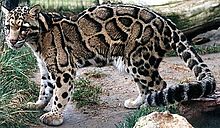Clouded leopard
| Clouded leopard | |
|---|---|

| |
| Clouded leopard in Kaeng Krachan National Park | |
| Scientific classification | |
| Domain: | Eukaryota |
| Kingdom: | Animalia |
| Phylum: | Chordata |
| Class: | Mammalia |
| Order: | Carnivora |
| Suborder: | Feliformia |
| Family: | Felidae |
| Subfamily: | Pantherinae |
| Genus: | Neofelis |
| Species: | N. nebulosa[1]
|
| Binomial name | |
| Neofelis nebulosa[1] (Griffith, 1821)
| |

| |
| Distribution of the clouded leopard[2] | |
The clouded leopard (Neofelis nebulosa), also called mainland clouded leopard, is a wild cat inhabiting dense forests from the foothills of the Himalayas through Northeast India and Bhutan to mainland Southeast Asia into South China. It was first described in 1821 on the basis of a skin of an individual from China. The clouded leopard has large dusky-grey blotches and irregular spots and stripes reminiscent of clouds. Its head-and-body length ranges from 68.6 to 108 cm (27.0 to 42.5 in) with a 61 to 91 cm (24 to 36 in) long tail. It uses its tail for balancing when moving in trees and is able to climb down vertical tree trunks head first. It rests in trees during the day and hunts by night on the forest floor.
The clouded leopard is the
The clouded leopard has been kept in
Taxonomy and phylogeny
Felis nebulosa was proposed by
Felis diardi proposed by Georges Cuvier in 1823 was based on a clouded leopard skin from Java.[9] It was considered a clouded leopard subspecies by Reginald Innes Pocock in 1917.[10] In 2006, it was identified as a distinct Neofelis species, the Sunda clouded leopard.[11][12] Populations in Taiwan and Hainan Island are considered to belong to the mainland clouded leopard.[8]
Phylogeny
Skulls of clouded leopard and Panthera species were analysed morphologically in the 1960s. Results indicate that the clouded leopard forms an evolutionary link between the Pantherinae and the Felinae.[13]
Characteristics
The clouded leopard's fur is of a dark grey or ochreous ground-color, often largely obliterated by black and dark dusky-grey blotched pattern. There are black spots on the head, and the ears are black. Partly fused or broken-up stripes run from the corner of the eyes over the cheek, from the corner of the mouth to the neck, and along the nape to the shoulders. Elongated blotches continue down the spine and form a single median stripe on the loins. Two large blotches of dark dusky-grey hair on the side of the shoulders are each emphasized posteriorly by a dark stripe, which passes on to the foreleg and breaks up into irregular spots. The flanks are marked by dark dusky-grey irregular blotches bordered behind by long, oblique, irregularly curved or looped stripes. These blotches yielding the clouded pattern suggest the English name of the cat. The underparts and legs are spotted, and the tail is marked by large, irregular, paired spots. Its legs are short and stout, and paws broad. Females are slightly smaller than males.[17]
Its
Its skull is long and low with strong occipital and sagittal crests. The canine teeth are exceptionally long, the upper being about three times as long as the basal width of the socket. The first premolar is usually absent.[17] The upper pair of canines measure 4 cm (1.6 in) or longer.[19] It has a
Distribution and habitat

The clouded leopard occurs from the
Clouded leopards were found in Nepal in 1987 and 1988, having previously been presumed to be extinct in the country.[22] Since then, the clouded leopard has been recorded in Shivapuri Nagarjun National Park and in Annapurna Conservation Area.[23][24] Between 2014 and 2015, it was also recorded in Langtang National Park at an elevation range of 1,823–3,498 m (5,981–11,476 ft).[25]
In India, it occurs in the states of
In Bhutan, it was recorded in
In Thailand, it inhabits relatively open,
The last confirmed record of a Formosan clouded leopard dates to 1989, when the skin of a young individual was found in the Taroko National Park.[45] It was not recorded during an extensive camera trapping survey conducted from 1997 to 2012 in more than 1,450 sites inside and outside Taiwanese protected areas.[46]
Behaviour and ecology
The clouded leopard is a solitary cat. Early accounts depict it as a rare, secretive,
It is one of the most talented climbers among the cats. Captive clouded leopards have been observed to climb down vertical tree trunks head first, and hang on to branches with their hind paws bent around branchings of tree limbs.
Radio-collared clouded leopards were foremost active by night but also showed
Home ranges have only been estimated in Thailand:
- Four individuals were radio-collared in Phu Khieo Wildlife Sanctuary from April 2000 to February 2003. Home ranges of two females were 25.7 km2 (9.9 sq mi) and 22.9 km2 (8.8 sq mi), and of two males 29.7 km2 (11.5 sq mi) and 49.1 km2 (19.0 sq mi).[39]
- Two individuals were radio-collared during a study from 1997 to 1999 in the Khao Yai National Park. The home range of one female was 39.4 km2 (15.2 sq mi), of the one male 42 km2 (16 sq mi). Both individuals had a core area of 2.9 km2 (1.1 sq mi).[48]
In 2016, clouded leopards were detected in the forest complex of Khlong Saeng Wildlife Sanctuary and Khao Sok National Park during camera trapping surveys; 15 individuals were identified in a core zone of 200 km2 (77 sq mi) with population density estimated at 5.06 individuals per 100 km2 (39 sq mi); but only 12 individuals were identified in an edge zone of 297 km2 (115 sq mi), which is more disturbed by humans, with density estimated at 3.13 individuals per 100 km2 (39 sq mi).[49]
Hunting and diet
When hunting, the clouded leopard stalks its prey or waits for the prey to approach. After making and feeding on a kill, it usually retreats into trees to digest and rest. Its prey includes both arboreal and terrestrial vertebrates.[19] Pocock presumed that it is adapted for preying upon
Reproduction and life cycle

Both males and females average 26 months at first reproduction. The female is in
The female gives birth to a litter of one to five, mostly three cubs, after a gestation period of 93 ± 6 days.[53] Cubs are born with closed eyes and weigh from 140 to 280 g (4.9 to 9.9 oz). Their spots are solid dark, rather than dark rings. Their eyes open after about 10 days. They are active within five weeks and fully weaned at around three months of age. They attain the adult coat pattern at around six months and become independent after around 10 months.[19]
Captive clouded leopards have an average lifespan of 11 years.[54] One individual has lived to be almost 17 years old.[55]
The generation length of the clouded leopard is about seven years.[56]
Threats

Clouded leopard require larger areas of intact forest than are present in many parts of their range.[57] They are threatened by habitat loss following large–scale deforestation and commercial poaching for the wildlife trade.[58] In Myanmar, 301 body parts of at least 279 clouded leopards, mostly skins and skeletons, were observed in four markets surveyed between 1991 and 2006, despite the protected status of clouded leopards in Myanmar. Some markets are located near Myanmar's borders with China and Thailand and are used to facilitate cross-border smuggling.[59]
In Nepal, 27 cases of clouded leopard body parts were discovered between November 1988 and March 2020 in nine districts of the country, comprising at least 51 individual clouded leopards. In 17 of these cases, the poachers and traders were arrested.[60]
Conservation

The clouded leopard is listed in
In the
International Clouded Leopard Day is celebrated each year on 4 August since 2018 in zoos and conservation organizations all over the world.[61]
In captivity

Clouded leopards have been kept in zoos since the early 20th century. The international
Early captive-breeding programs involving clouded leopards were not successful, largely due to ignorance of their courtship behaviour. Males have the reputation of being aggressive towards females. For breeding success, it has been deemed extremely important that male and female clouded leopards are compatible.[19] Introducing pairs at a young age gives them opportunities to bond and breed successfully. Facilities breeding clouded leopards need to provide the female with a secluded, off-exhibit area.[20] There has been some recent captive breeding success using artificial insemination with cubs successfully born in 1992, 2015 and 2017.[63]
A study on
In March 2011, two breeding females at the Nashville Zoo at Grassmere gave birth to three cubs, which were raised by zookeepers. Each cub weighed 0.23 kg (0.5 lb).[65] In June 2011, two cubs were born at the Point Defiance Zoo & Aquarium. The breeding pair was brought from the Khao Kheow Open Zoo in Thailand in an ongoing education and research exchange program.[66] Four cubs were born at Nashville Zoo in 2012.[67] In May 2015, four cubs were born in Point Defiance Zoo & Aquarium.[68]
In culture
The clouded leopard is the state animal of the Indian state of Meghalaya.[69] In the 1970s, the print of Rama Samaraweera's painting Clouded leopard was a best-seller in the US.[70]
See also
References
- ^ OCLC 62265494.
- ^ . Retrieved 19 November 2021.
- ^ Griffith, E. (1821). "The Chinese, or tortoiseshell Tiger. Felis nebulosa". General and particular descriptions of the vertebrated animals arranged comfortably to the modern discoveries and improvements in zoology. London: Baldwin, Cradock & Joy. p. 37. Archived from the original on 10 February 2023. Retrieved 19 November 2020.
- ^ Hodgson, B. H. (1841). "Classified Catalogue of Mammals of Nepal". Calcutta Journal of Natural History and Miscellany of the Arts and Sciences in India. IV: 284–294. Archived from the original on 10 February 2023. Retrieved 10 May 2018.
- ^ Hodgson, B. H. (1853). "Felis macrosceloides". Proceedings of the Zoological Society of London. I. Mammalia: Plate XXXVIII.
- .
- ^ Gray, J. E. (1867). "Notes on the skulls of cats (Felidae)". Proceedings of the Zoological Society of London. 35: 258–277.
- ^ a b Kitchener, A. C.; Breitenmoser-Würsten, C.; Eizirik, E.; Gentry, A.; Werdelin, L.; Wilting, A.; Yamaguchi, N.; Abramov, A. V.; Christiansen, P.; Driscoll, C.; Duckworth, J. W.; Johnson, W.; Luo, S.-J.; Meijaard, E.; O’Donoghue, P.; Sanderson, J.; Seymour, K.; Bruford, M.; Groves, C.; Hoffmann, M.; Nowell, K.; Timmons, Z. & Tobe, S. (2017). "A revised taxonomy of the Felidae: The final report of the Cat Classification Task Force of the IUCN Cat Specialist Group" (PDF). Cat News (Special Issue 11): 64–66. Archived (PDF) from the original on 17 January 2020. Retrieved 20 December 2020.
- ^ Cuvier, G. (1823). "Des ossemens des grands Felis". Recherches sur les ossemens fossiles : où l'on rétablit les caractères de plusieurs animaux dont les révolutions du globe ont détruit les espèces. Volume IV: Les ruminans et les carnassiers fossiles. Paris: G. Dufour & E. d'Ocagne. pp. 407−456. Archived from the original on 10 February 2023. Retrieved 17 November 2020.
- .
- ^ PMID 17141620.
- S2CID 6838593.
- ^ a b c Hemmer, H. (1968). "Untersuchungen zur Stammesgeschichte der Pantherkatzen (Pantherinae) II: Studien zur Ethologie des Nebelparders Neofelis nebulosa (Griffith 1821) und des Irbis Uncia uncia (Schreber 1775)" [Researching the phylogenetic history of the Pantherinae II: Studies into the ethology of the clouded leopard Neofelis nebulosa and snow leopard Uncia uncia]. Veröffentlichungen der Zoologischen Staatssammlung München. 12: 155–247.
- ^ from the original on 4 October 2020. Retrieved 11 September 2019.
- ISBN 978-0-19-923445-5. Archivedfrom the original on 25 September 2018. Retrieved 16 September 2019.
- PMID 26518481.
- ^ a b c Pocock, R.I. (1939). "Genus Neofelis Gray. The Clouded Leopard". The Fauna of British India, including Ceylon and Burma. Vol. Mammalia. – Volume 1. London: Taylor and Francis, Ltd. pp. 247–253.
 This article incorporates text from this source, which is in the public domain.
This article incorporates text from this source, which is in the public domain.
- ^ ISBN 978-0-8008-8324-9.
- ^ ISBN 978-0-226-77999-7. Archivedfrom the original on 10 February 2023. Retrieved 26 November 2020.
- ^ a b Clouded Leopard SSP (2000). Clouded leopard (Neofelis nebulosa) Husbandry Guidelines (PDF). Silver Spring: Association of Zoos and Aquariums. Archived (PDF) from the original on 17 October 2013. Retrieved 27 January 2013.
- PMID 17479753.
- S2CID 86485712.
- ^ Pandey, B. P. (2012). "Clouded leopard in Shivapuri Nagarjun National Park, Nepal". Cat News (57): 24–25.
- ^ Ghimirey, Y.; Acharya, R.; Adhikary, B.; Werhahn, G. & Appel, A. (2013). "Clouded leopard camera-trapped in the Annapurna Conservation Area, Nepal". Cat News (58): 25.
- .
- .
- ^ Choudhury, A. U. (1996). "The clouded leopard". Cheetah. 35 (1–2): 13–18.
- ^ Choudhury, A. (1997). "The clouded leopard in Manipur and Nagaland". Journal of the Bombay Natural History Society. 94 (2): 389–391.
- ^ Choudhury, A. U. (2003). "The cats in North East India". Cat News. 39: 15–19.
- ^ Borah, J.; Sharma, T.; Lyngdoh, S. & Tapi, T. (2010). "First photograph of a clouded leopard at Pakke Tiger Reserve, India". Cat News (52): 24–25.
- S2CID 52205824.
- .
- ^ .
- .
- PMID 29721297.
- .
- .
- S2CID 84998140.
- ^ S2CID 86640520.
- ^ Austin, S. C.; Tewes, M. E.; Grassman, L. I. Jr. & Silvy, N. J. (2007). "Ecology and conservation of the leopard cat Prionailurus bengalensis and clouded leopard Neofelis nebulosa in Khao Yai National Park, Thailand". Acta Zoologica Sinica. 53: 1–14.
- .
- ^ Gray, T.N. & Phan, C. (2011). "Habitat preferences and activity patterns of the larger mammal community in Phnom Prich Wildlife Sanctuary, Cambodia". The Raffles Bulletin of Zoology. 59 (2): 311–318.
- ^ Gray, T.N.; Billingsley, A.; Crudge, B.; Frechette, J.L.; Grosu, R.; Herranz-Muñoz, V.; Holden, J.; Keo, O.; Kong, K.; Macdonald, D. & Neang, T. (2017). "Status and conservation significance of ground-dwelling mammals in the Cardamom Rainforest Landscape, southwestern Cambodia". Cambodian Journal of Natural History. 2017 (1): 38–48.
- .
- ^ Anonymous (1996). "The mystery of the Formosan clouded leopard". Cat News. 24: 16.
- .
- ^ Fazio, J. M. (2010). Behavioral Assessment of the Clouded Leopard (Neofelis nebulosa); A Comparative Study of Reproductive Success (MSc). Fairfax, VA: George Mason University.
- ^ Austin, S. C. & Tewes, M. E. (1999). "Ecology of the clouded leopard in Khao Yai National Park, Thailand". Cat News (31): 17–18.
- .
- ^ Davies, R.G. (1990). "Sighting of a clouded leopard (Neofelis nebulosa) in a troop of pigtail macaques (Macaca nemestrina) in Khao Yai National Park, Thailand". Siam Society Natural History Bulletin. 38: 95–96.
- ^ Feng, L.; Lin, L.; Zhang, L.; Wang, L.; Wang, B.; Luo, A.; Yang, S.; Smith, J. L. D.; Luo, S. J. & Zhang, L. (2008). "Evidence of wild tigers in southwest China – a preliminary survey of the Xishuangbanna National Nature Reserve". Cat News (48): 4–6.
- ^ Lam, W.Y.; Hedges, L. & Clements, G.R. (2014). "First record of a clouded leopard predating on a binturong". Cat News (60): 16.
- ^ a b c Nowell, K. & Jackson, P. (1996). "Clouded Leopard". Wild Cats: Status Survey and Conservation Action Plan. Gland: IUCN/SSC Cat Specialist Group. Archived from the original on 3 June 2007.
- ^ Achariyo, L. N. & Mishra, Ch. G. (1981). "Some notes on the longevity of two species of Indian wild cats in captivity". Journal of the Bombay Natural History Society. 78: 155. Archived from the original on 2 August 2020. Retrieved 9 April 2020.
- ^ "Clouded leopard". The Aspinall Foundation. n.d. Archived from the original on 18 April 2014.
- .
- PMID 17092347.
- ^ a b Nowell, K. (2007). Asian big cat conservation and trade control in selected range States: evaluating implementation and effectiveness of CITES Recommendations (PDF) (Report). Kuala Lumpur: TRAFFIC. Archived (PDF) from the original on 3 October 2020. Retrieved 9 October 2010.
- ^ Shepherd, C. R. & Nijman, V. (2008). The wild cat trade in Myanmar (PDF) (Report). Petaling Jaya, Selangor, Malaysia: TRAFFIC Southeast Asia. Archived (PDF) from the original on 23 January 2021. Retrieved 20 December 2020.
- S2CID 230543392.
- ^ "International Clouded Leopard Day". The Aspinall Foundation. Archived from the original on 5 August 2019. Retrieved 5 August 2019.
- ^ Wildlife Institute of India (2014). "Status in captivity". National Studbook of Clouded leopard (Neofelis nebulosa). TR. No. -2014/ 010 (PDF). New Delhi: Central Zoo Authority. p. 5. Archived (PDF) from the original on 11 May 2019. Retrieved 11 May 2019.
- ^ "First Clouded Leopard Cub Produced with Cryopreserved Semen". Smithsonian's National Zoo. 2017. Archived from the original on 22 October 2020. Retrieved 1 November 2020.
- S2CID 213184824.
- LiveScience. 2011. Archivedfrom the original on 3 October 2014.
- ^ "Welcome Our New Clouded Leopard Cubs". Point Defiance Zoo & Aquarium. 2011. Archived from the original on 27 June 2011.
- ^ "The Nashville Zoo celebrates two sets of clouded leopard cubs". Associated Press. 2012. Archived from the original on 3 June 2013.
- ^ "Four extremely rare leopards born in US zoo". RTÉ. 2015. Archived from the original on 24 May 2015. Retrieved 23 May 2015.
- ^ "State Animals, Birds, Trees and Flowers of India". ENVIS RP on Forestry and Forest Related Livelihoods, Ministry of Environment & Forests, Government of India. 2011. Archived from the original on 8 March 2016. Retrieved 7 June 2017.
- ^ "DZG inspired acclaimed artist". Archived from the original on 5 March 2018. Retrieved 6 September 2016.
External links
- "Mainland clouded leopard Neofelis nebulosa". IUCN Species Survival Commission Cat Specialist Group.
- "Clouded Leopard Neofelis nebulosa". National Geographic. Archived from the originalon 24 February 2012.
- "Taiwan's clouded leopard extinct: zoologists". Focus Taiwan. 2013.
- "Clouded Leopard: Facing Dark Clouds of Extinction". About Animals. 20 June 2016.



